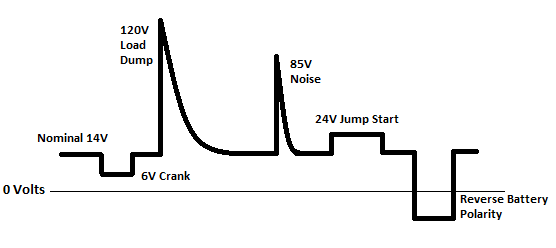SSZT783 february 2018 TLIN2022-Q1 , TLIN2029-Q1 , TLIN2441-Q1
Automobiles are becoming more advanced every day. The number of integrated circuits (ICs) is increasing every year and spreading to more modules within the automobile to control lights, heating, sensors and more. The new paradigm of designing automobiles with more features and electrical controls raises the question of whether this is safe, and whether ICs can withstand the voltage transients common in automotive environments.
Of course, if you apply a 12V power supply to a microcontroller requiring a 3.3V supply, the device will not operate correctly and you run the risk of catastrophic failure. The same principle applies to transients in the automotive environment, whose voltages can rise (or become negative) far beyond the specifications of the ICs. Transients are even more severe in 24V-battery systems like commercial trucks, forklifts and mass transit vehicles.
Nearly every car in the world uses the Local Interconnect Network (LIN) protocol. Modules that use LIN connect directly to the car battery through a diode; LIN transceivers that send and receive data across the LIN bus experience transients all the time. It is vital that you choose a LIN transceiver that is sufficiently protected from transients so that different modules in the car can communicate effectively. Figure 1 shows the most common automobile transients.
 Figure 1 Common Automobile
Transients
Figure 1 Common Automobile
TransientsAt the top of the dangerous transients list is the load dump, also known as a battery disconnect from the alternator. The alternator (the voltage source) is delivering charging current to the battery (the load). Due to the large inductance in the alternator and the drastic change in load current due to the battery being disconnected from the system in a short amount of time, there is a large voltage spike that all the remaining nodes connected to the alternator will see (V = L*di/dt). These voltage spikes can range anywhere from 25V to 120V, as shown in Figure 1. While this is a relatively short transient (milliseconds), some transients can last for several minutes.
Jump-starting a car is something most drivers have experienced. Jump-starts can be detrimental to ICs and electrical devices inside. The voltage regulators are intending to step down or step up automobiles supplied with a 12V battery (or a 24V battery in commercial vehicles). Roadside service vehicles typically use 24V batteries (or 48V batteries for commercial vehicles) to jump-start cars; this means your car is receiving two times the expected voltage. Electronic devices in the car may be exposed to this transient for up to five minutes as the jump-start procedure concludes.
The new TLIN family of LIN transceivers has robust performance in both 12V consumer and 24V (or higher) commercial vehicles. You can directly connect ICs to the system battery and provide communication between all modules in the car. They are built to withstand transients (load dumps), have a wide operating range (for jump-starts) and include DC fault protection (for reverse-battery) while increasing the speed and reliability of the LIN bus. Check out the TLIN2029-Q1 to learn more about 24V application capabilities.
Additional Resources
- Learn more about LIN and how it solves problems in automobiles in this blog, “LIN – The Last Mile Network”
- To see how LIN technology can be incorporated into today's vehicles, check out this 360 tour.
- For advanced knowledge on the electrical characteristic of LIN, check out this TI application note.